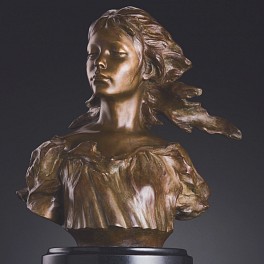BIOGRAPHY

1943 - 1999
"If art is to flourish in the twenty-first century, it must renew its moral authority by rededicating itself to life. It must be an enriching, ennobling and vital partner in the public pursuit of civilization. It should be a majestic presence in everyday life just as it was in the past."
- Frederick Hart
Frederick Hart is America's greatest figurative sculptor. Not only did he create works of great beauty and gravitas, he was singularly responsible for restoring to American public monuments and memorials an iconology worthy of a great nation.
Frederick Hart was born in Atlanta in 1943, while his father was serving in the Navy in World War II. When he was only three years old, his mother died suddenly. Hart was subsequently cared for by his mother's family in rural South Carolina where the earliest years of his childhood were spent. He moved to Washington, D.C. when his father remarried in the early 1950s and attended public school there. At the age of sixteen, based on his high S.A.T. scores, he was admitted as a philosophy major to the University of South Carolina.
Hart returned to Washington, D.C. with a desire to study art and attended the Corcoran School of Art and American University where he studied painting and drawing. At first drawing was his obsession; but later after sculpting a bust of a girlfriend, he realized, for the first time, that here was drawing that possessed weight, volume, presence and gravity.
As his interest in sculpture began to flourish, Frederick Hart became an apprentice stone carver at the National Cathedral in Washington, D.C. working on gargoyles. Quite possible the last great Gothic cathedral, it was a national church, which took eighty-three years to build.
In 1971, while Hart was still working on the stone of the cathedral, an international competition was announced to find a sculptor for the cathedral's west facade. Hart worked passionately on his design for three years, and at the young age of thirty-one, he won the commission. "I was convinced I was destined to do this," Hart said. It was an assignment that occupied virtually the next thirteen years of his life. The commission was to portray in stone a contemporary interpretation of the great theme of Creation above the main entrance. From a seething cauldron of swirling motion human forms emerge - hands, faces, bodies, swept up in the exultation of being given life.
In 1982 the Vietnam Veterans War Memorial Fund commissioned Frederick Hart to create a representational sculpture for their monument. This historic work in bronze was dedicated in November, 1984.
During his career Hart worked brilliantly in several different mediums, eliciting what is most pleasing in each. His private and public works share a philosophical approach and longing for perfection. Hart's success as a sculptor was achieved at great personal cost. He had to acquire and master the lost craft of figurative sculpture. A great deal of soul searching and education were necessary to develop the spiritual iconography that shaped his vision.
"Hart's work is about Transcendence and Renewal... At certain moments in history, one encounters a work of art that possesses the aesthetic, contextual and moral strength to signal the start of a new era. The creation Sculptures is such a work... it has the tender power of a Michelangelo"
- James F. Cooper
